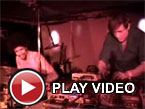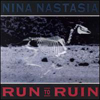 These songs make me into another person. I'm a criminal, then a scaredlittle boy, and the next minute I'm the loner walking through thedesert with a storm at my back. Nina Nastasia forces me to assume theseroles with her voice in my ear and her guitars cutting down at me likevicious slaps. One minute I'm in quiet solitude, hiding in a thicketand the next I'm being whipped around by a squall bursting withlightning and unexhaustable power. Run to Ruinis just that: powerful and excited. Nastasia's voice is absolutelyentrancing and the instrumentation is a fluid swarm of acousticstrumming, near-classical arrangements, and cabaret-styled,instrumental passages. "We Never Talked" starts the album as theperfect preface. Nastasia's lyrics are somewhat vague and manage toevoke a sense of wonder and mystery in every song, but especially onthe opener. "In the car, you'd have brought it up / But I went on aboutthat job / All the love I have left you won't know / All the fear Ihave left you won't know." The way it's sung puts a knot in my stomachevery time... and then the storm begins. "I Say That I Will Go" is astory about keeping a promise. It has a deliciously twisted ending thatsuggests all sorts of mischievousness. Violins, cellos, banjo,dulcimer, piano, and some distinctive drumming from Jim White of DirtyThree drift, collide, and wail with Nastasia's excellent story-tellingand clear, graceful, and at times absolutely earth-shattering voice.Though the album runs at just over thirty minutes long, each song isfull of character and developed completely. There's more variety on Run to Ruinthan on most albums that last twice as long. "The Body" begins like animitation-baroque piece and "On Teasing" sounds like a tale told bygypsies around camp fire; it features an instrumental duel that soundsas if it comes from the spirit world. "You Her and Me" creates a hybridsound that holds country and folk music dear to the heart but is muchmore bare and delicate. Despite all the acoustic and familiarinstruments used, this is a unique album with a myriad of styles andalien melodies. Every time I play this record, it's like beingtransported to another world. Not one song is disposable and after thealbum stops, I have this incredible urge to play it again just so I candrift away.
These songs make me into another person. I'm a criminal, then a scaredlittle boy, and the next minute I'm the loner walking through thedesert with a storm at my back. Nina Nastasia forces me to assume theseroles with her voice in my ear and her guitars cutting down at me likevicious slaps. One minute I'm in quiet solitude, hiding in a thicketand the next I'm being whipped around by a squall bursting withlightning and unexhaustable power. Run to Ruinis just that: powerful and excited. Nastasia's voice is absolutelyentrancing and the instrumentation is a fluid swarm of acousticstrumming, near-classical arrangements, and cabaret-styled,instrumental passages. "We Never Talked" starts the album as theperfect preface. Nastasia's lyrics are somewhat vague and manage toevoke a sense of wonder and mystery in every song, but especially onthe opener. "In the car, you'd have brought it up / But I went on aboutthat job / All the love I have left you won't know / All the fear Ihave left you won't know." The way it's sung puts a knot in my stomachevery time... and then the storm begins. "I Say That I Will Go" is astory about keeping a promise. It has a deliciously twisted ending thatsuggests all sorts of mischievousness. Violins, cellos, banjo,dulcimer, piano, and some distinctive drumming from Jim White of DirtyThree drift, collide, and wail with Nastasia's excellent story-tellingand clear, graceful, and at times absolutely earth-shattering voice.Though the album runs at just over thirty minutes long, each song isfull of character and developed completely. There's more variety on Run to Ruinthan on most albums that last twice as long. "The Body" begins like animitation-baroque piece and "On Teasing" sounds like a tale told bygypsies around camp fire; it features an instrumental duel that soundsas if it comes from the spirit world. "You Her and Me" creates a hybridsound that holds country and folk music dear to the heart but is muchmore bare and delicate. Despite all the acoustic and familiarinstruments used, this is a unique album with a myriad of styles andalien melodies. Every time I play this record, it's like beingtransported to another world. Not one song is disposable and after thealbum stops, I have this incredible urge to play it again just so I candrift away.samples:


 Austrian-born Rancho Relaxo All Stars collaborator Susanne Brokesch isan electronic-based sound artist whose work has resulted in variousoutputs such as group art shows, soundtrack work and several recordingsunder her own name as well as the pseudonyms of Sil and SilElectronics. Her latest release, So Easy, Hard To Practice,is mostly a collection of various soundscapes and minimalist-typecompositions where, at times, the rhythms are implied more thanoutright stated. What I found to be interesting about this disc isBrokesch's arrangement of synthetic sound patches, which at timesconvey a somewhat organic feel. The mild pulsing of "Confidence" laysbeneath a wash of obscure drones and sci-fi movie lasergun blast soundswith the occasional squelch until sparse, linear drum machine patternsmove in to take the track out. "Bel Air Mix 1" is a nice and subtleblend of reverbed synthesizer chords and heaving electro-cello over topof quiet, swinging drum machine tom-tom and snare hits which fade inand out throughout the mix. Rounding out the disc's forty minutes isthe somewhat out of place and longest track, aptly titled "Dancing."The mid-tempo programmed rhythms and syncopated bass end thump awayagainst a backdrop of flitting, somewhat harsh treated synths and othernear-industrial type sounds. The introduction of electro percussion andhandclaps add to the dance elements which are already very prominent.Although too fractured to be considered an ambient-type disc andgenerally lacking a steady pulse for head nodding, the interesting makeup of So Easy, Hard To Practice finds a fair middle ground that had me following the shifts without it being too obvious.
Austrian-born Rancho Relaxo All Stars collaborator Susanne Brokesch isan electronic-based sound artist whose work has resulted in variousoutputs such as group art shows, soundtrack work and several recordingsunder her own name as well as the pseudonyms of Sil and SilElectronics. Her latest release, So Easy, Hard To Practice,is mostly a collection of various soundscapes and minimalist-typecompositions where, at times, the rhythms are implied more thanoutright stated. What I found to be interesting about this disc isBrokesch's arrangement of synthetic sound patches, which at timesconvey a somewhat organic feel. The mild pulsing of "Confidence" laysbeneath a wash of obscure drones and sci-fi movie lasergun blast soundswith the occasional squelch until sparse, linear drum machine patternsmove in to take the track out. "Bel Air Mix 1" is a nice and subtleblend of reverbed synthesizer chords and heaving electro-cello over topof quiet, swinging drum machine tom-tom and snare hits which fade inand out throughout the mix. Rounding out the disc's forty minutes isthe somewhat out of place and longest track, aptly titled "Dancing."The mid-tempo programmed rhythms and syncopated bass end thump awayagainst a backdrop of flitting, somewhat harsh treated synths and othernear-industrial type sounds. The introduction of electro percussion andhandclaps add to the dance elements which are already very prominent.Although too fractured to be considered an ambient-type disc andgenerally lacking a steady pulse for head nodding, the interesting makeup of So Easy, Hard To Practice finds a fair middle ground that had me following the shifts without it being too obvious.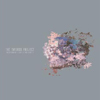 The title of this album leads one to wonder if it is in a way, a slyindictment of certain purveyors of experimental, progressive, orpost-rock music that they themselves are one of. Are they trying to saythat perhaps these genres are somewhat more susceptible toself-indulgence at the expense of entertainment? In any case, themembers of the Swords Project are at least saying that we have a choicein the matter and in that spirit they seize control of their musicaldestiny presenting an album that is both complex and enjoyable. Theirmusic has a shimmering, buoyant quality that wraps around itself in adizzying assemblage of layers. "City Life" is a veritable möbius strip,beginning with the faint, choppy voice of vocalist seeping through apastiche of programmed train-chugging drumbeats, static, and electronicmanipulation. The beats soon crackle into live drums and a flickeringmelody begins to unfold, floating without an anchor in the musicsurrounding it, like catching faint sight of a porch light through athicket of trees. It sounds as if the core of the song is bursting fromwithin with only enough energy to fall back into itself and repeat thesame process once again, leaving behind a mesmerizing vapor trail as itsinks back to earth. "MD11" reveals a cleaner sound, moving swiftly andbuilding off of a single melodic idea throughout the song. It seemslike more of a rock song than the tracks that precede even as itbriefly delves into a stutter-glitch bridge. "Cocktails andShuttlecocks" continues in this vein, though it progresses in a moresubdued shoegazer style, utilizing a violin for dramatic effect amidstthe warm bass lines and gentle melody. "Audience of One" takes theatmosphere of that previous track and expands upon it instrumentally,and by using minimal whispered vocals the band allows the violin totake the forefront in what makes for a really impressive long piece.They balance space and dynamics extremely well, building tension andtaking the music through peaks and valleys that make the track a truestandout. "Immigracion" presents itself as a rather standard indie rocksong, perhaps more in the vein of Death Cab for Cutie than any of thereferences the band itself might name check. By this point in thealbum, it seems like the collage aspects presented in "City Life" havebeen altogether abandoned, and that is a shame, but what remains isstill an interesting collection of songs that have a knack for melodyplayed by a band in perfect harmony with one another. The SwordsProject closes with "New Shapes," a long, droning track thatincorporates some elements of their earlier flair, but never commits tothe sound fully. The song is slow to develop, but with patience thefinal minutes take off into a propulsive workout. Throughout the album,the percussion is a major highlight. It fits each compositionperfectly, knowing the right time to sit back and let the rest of theband squall along and when to push through the din to give the piece alittle extra oomph. Entertainment is Over if You Want Itseems to lean away from the more brazen attempts at experimentation ofit's contemporaries, instead bringing these elements into the music inbrief spurts or bursts. At its core is just good music, approached witha sense of what makes for a compelling and enjoyable listen.
The title of this album leads one to wonder if it is in a way, a slyindictment of certain purveyors of experimental, progressive, orpost-rock music that they themselves are one of. Are they trying to saythat perhaps these genres are somewhat more susceptible toself-indulgence at the expense of entertainment? In any case, themembers of the Swords Project are at least saying that we have a choicein the matter and in that spirit they seize control of their musicaldestiny presenting an album that is both complex and enjoyable. Theirmusic has a shimmering, buoyant quality that wraps around itself in adizzying assemblage of layers. "City Life" is a veritable möbius strip,beginning with the faint, choppy voice of vocalist seeping through apastiche of programmed train-chugging drumbeats, static, and electronicmanipulation. The beats soon crackle into live drums and a flickeringmelody begins to unfold, floating without an anchor in the musicsurrounding it, like catching faint sight of a porch light through athicket of trees. It sounds as if the core of the song is bursting fromwithin with only enough energy to fall back into itself and repeat thesame process once again, leaving behind a mesmerizing vapor trail as itsinks back to earth. "MD11" reveals a cleaner sound, moving swiftly andbuilding off of a single melodic idea throughout the song. It seemslike more of a rock song than the tracks that precede even as itbriefly delves into a stutter-glitch bridge. "Cocktails andShuttlecocks" continues in this vein, though it progresses in a moresubdued shoegazer style, utilizing a violin for dramatic effect amidstthe warm bass lines and gentle melody. "Audience of One" takes theatmosphere of that previous track and expands upon it instrumentally,and by using minimal whispered vocals the band allows the violin totake the forefront in what makes for a really impressive long piece.They balance space and dynamics extremely well, building tension andtaking the music through peaks and valleys that make the track a truestandout. "Immigracion" presents itself as a rather standard indie rocksong, perhaps more in the vein of Death Cab for Cutie than any of thereferences the band itself might name check. By this point in thealbum, it seems like the collage aspects presented in "City Life" havebeen altogether abandoned, and that is a shame, but what remains isstill an interesting collection of songs that have a knack for melodyplayed by a band in perfect harmony with one another. The SwordsProject closes with "New Shapes," a long, droning track thatincorporates some elements of their earlier flair, but never commits tothe sound fully. The song is slow to develop, but with patience thefinal minutes take off into a propulsive workout. Throughout the album,the percussion is a major highlight. It fits each compositionperfectly, knowing the right time to sit back and let the rest of theband squall along and when to push through the din to give the piece alittle extra oomph. Entertainment is Over if You Want Itseems to lean away from the more brazen attempts at experimentation ofit's contemporaries, instead bringing these elements into the music inbrief spurts or bursts. At its core is just good music, approached witha sense of what makes for a compelling and enjoyable listen. Greg Davis has spent the past few years finding the perfect crossbetween the real and the artificial, manufacturing music that is parttraditional instrumentation, part electronic samplings. Precursorsis presumably named for the fact that these songs precede his newalbum, and offer hints to the songs he's been working on. The frequenttourmate of Hrvatski has apparently unearthed something heretoforeuncharted within himself, as these songs represent a marked departurefrom his usual style, and also a less organized vision. Where beforeDavis would use acoustic guitars and electronic percussion to create arelaxed mood, "Lightning Proves to be Unnecessary" opens with an almostcacophonous display of noise. Organs are melded to electronic scratchesand other noises that build and grow to what seems like a forcedclimax. Then silence. Farm noises fill the air next, as a rooster crowsand birds can be heard in the distance. It's the battle, the anger, theblood and bone crushes, and then suddenly elysium. Acoustic guitar andorgans play out a funeral march or fitting tribute to a fallen comrade.Although the melody grows monotonous over the brief length of thetrack, there is a beauty to it all that warms the heart nonetheless. Onthe flipside is more percussion-less music from Davis, with clarinet,melodica, Rhodes piano, and guitar forming a simple yet swellingprogression. Eventually more instruments are added, creating a jarringstutter with instruments playing on the up and down beats.Full-sounding while delicate, the track never progesses much past that,but luckily it never threatens or promises to. It's all veryminimalist, and a new start for Davis, one that should hopefully seemore complicated structures come to fruition. This is just a taste, anda good one at that.
Greg Davis has spent the past few years finding the perfect crossbetween the real and the artificial, manufacturing music that is parttraditional instrumentation, part electronic samplings. Precursorsis presumably named for the fact that these songs precede his newalbum, and offer hints to the songs he's been working on. The frequenttourmate of Hrvatski has apparently unearthed something heretoforeuncharted within himself, as these songs represent a marked departurefrom his usual style, and also a less organized vision. Where beforeDavis would use acoustic guitars and electronic percussion to create arelaxed mood, "Lightning Proves to be Unnecessary" opens with an almostcacophonous display of noise. Organs are melded to electronic scratchesand other noises that build and grow to what seems like a forcedclimax. Then silence. Farm noises fill the air next, as a rooster crowsand birds can be heard in the distance. It's the battle, the anger, theblood and bone crushes, and then suddenly elysium. Acoustic guitar andorgans play out a funeral march or fitting tribute to a fallen comrade.Although the melody grows monotonous over the brief length of thetrack, there is a beauty to it all that warms the heart nonetheless. Onthe flipside is more percussion-less music from Davis, with clarinet,melodica, Rhodes piano, and guitar forming a simple yet swellingprogression. Eventually more instruments are added, creating a jarringstutter with instruments playing on the up and down beats.Full-sounding while delicate, the track never progesses much past that,but luckily it never threatens or promises to. It's all veryminimalist, and a new start for Davis, one that should hopefully seemore complicated structures come to fruition. This is just a taste, anda good one at that.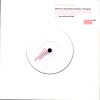 The second single in the Safe as Milk/Melektronikk collaborativeMilkland series brings together two subjects that couldn't be moreopposite from each other, and that seems to be part of the point. Safeas Milk is a Norwegian label that releases acts more rock in nature,while its sister label Melektronikk specializes in acts that areexperimental electronic; so any collaboration between the two will havemixed effects on the psyche, as this one does in spades. Milkland 2features Vibracathedral Orchestra, whose music easily reminds me ofasylums. Not the patients, mind you, because I think this music woulddrive them even more over the edge if they heard it; but I clearly feelthe waiting rooms and observation stations where you can actually seethe afflicted in this music. I imagined an entire dance troupe ofloonies, or as I called them the Psychotic Conservatory, flailingaround in anger, sitting in the middle of the floor chanting nonsense,and crying while jumping up and down. "Rain Gutter Teasing Rusty CatSneezing" is an amalgam of instruments and sounds that is not easilydigested or understood, and although I found it at the same timeinteresting and unnerving, it made me want to listen to their atonaldrone more. Phonophani, on the other hand, a side project of Alogmember Espen Sommer Eide, is manic noise of a far different sort. Beepsand bloops are the main percussion of "Bees - They Will Sting You" fora few seconds, then layer upon layer of flourish and glitch are addedon top, compelling the rhythm and tone into some bizarre roboticchoreography. Eventually, it seems as though the machines are acting ontheir own accord, no longer caring or paying attention to what thehuman programming them is asking or wants. Wonderfully creative musicfrom both artists, even though it makes me ponder whether either has ascrew or two loose.
The second single in the Safe as Milk/Melektronikk collaborativeMilkland series brings together two subjects that couldn't be moreopposite from each other, and that seems to be part of the point. Safeas Milk is a Norwegian label that releases acts more rock in nature,while its sister label Melektronikk specializes in acts that areexperimental electronic; so any collaboration between the two will havemixed effects on the psyche, as this one does in spades. Milkland 2features Vibracathedral Orchestra, whose music easily reminds me ofasylums. Not the patients, mind you, because I think this music woulddrive them even more over the edge if they heard it; but I clearly feelthe waiting rooms and observation stations where you can actually seethe afflicted in this music. I imagined an entire dance troupe ofloonies, or as I called them the Psychotic Conservatory, flailingaround in anger, sitting in the middle of the floor chanting nonsense,and crying while jumping up and down. "Rain Gutter Teasing Rusty CatSneezing" is an amalgam of instruments and sounds that is not easilydigested or understood, and although I found it at the same timeinteresting and unnerving, it made me want to listen to their atonaldrone more. Phonophani, on the other hand, a side project of Alogmember Espen Sommer Eide, is manic noise of a far different sort. Beepsand bloops are the main percussion of "Bees - They Will Sting You" fora few seconds, then layer upon layer of flourish and glitch are addedon top, compelling the rhythm and tone into some bizarre roboticchoreography. Eventually, it seems as though the machines are acting ontheir own accord, no longer caring or paying attention to what thehuman programming them is asking or wants. Wonderfully creative musicfrom both artists, even though it makes me ponder whether either has ascrew or two loose. Smyglyssna is Henrik Johansson, a Swedish electronic musician who isdesperately hoping that the music-buying public will be able todistinguish the music on his new album We Can Fix Itfrom that of his numerous European contemporaries. Perhaps I don'tpossess an ear properly tuned towards these subtle distinctions, but itseems that Johansson has produced an album that is more or less wearingthe IDM uniform: a postmodern combination of beats lifted from the past20 years of electronic music, processed and edited within an inch ofits life with the kind of surgical precision only possible with anexpensive new Powerbook. The nine tracks add up to something slightlybetter than average, but slightly less than great. "Might-It-Be's andIf-It-Were's" opens with some creepy alien sound washes, before Mr.Johansson introduces his limited sound palette, which involves CarlCraig-style Detroit electro with all booty-shaking potential carefullyremoved and replaced with a dry, academic contempt for accessibility.It bears more than a passing resemblance to earlier IDM such as BlackDog Productions, with its shifting patterns and cubist beatconstruction. It all comes together nicely, and even achieves somegenuinely funky moments, but I can't help feeling that this kind ofthing was a bit more compelling five years ago. For its entiresix-minute length, "Work Shall Be Abolished" threatens to turn into afull-on electro-funk song, but Johansson is too restrained to engage inanything that might be construed as fun. "Triangular Ears" is probablythe best track on the album, as it is the one time Johansson fullyabsorbs the listener in his infectious beat construction, with funny,eclectic sounds that are reminiscent of Mouse on Mars. The ugly loomingspectre of Boards of Canada haunts most modern electronic artists, andmany seem afraid to venture out of their shadow. Smyglyssna is noexception, with his obvious BoC pastiche "Foaming Prairie," a pastoralkeyboard melody matched with hazy distortions. The R&B flavored"Tea With Angela" finishes the album on a slightly messy note. Ibelieve there is hope for Smyglyssna, if he can somehow manage toremove his head from the collective ass of the European IDMcommunity and make something that sounds a little less like everythingelse.
Smyglyssna is Henrik Johansson, a Swedish electronic musician who isdesperately hoping that the music-buying public will be able todistinguish the music on his new album We Can Fix Itfrom that of his numerous European contemporaries. Perhaps I don'tpossess an ear properly tuned towards these subtle distinctions, but itseems that Johansson has produced an album that is more or less wearingthe IDM uniform: a postmodern combination of beats lifted from the past20 years of electronic music, processed and edited within an inch ofits life with the kind of surgical precision only possible with anexpensive new Powerbook. The nine tracks add up to something slightlybetter than average, but slightly less than great. "Might-It-Be's andIf-It-Were's" opens with some creepy alien sound washes, before Mr.Johansson introduces his limited sound palette, which involves CarlCraig-style Detroit electro with all booty-shaking potential carefullyremoved and replaced with a dry, academic contempt for accessibility.It bears more than a passing resemblance to earlier IDM such as BlackDog Productions, with its shifting patterns and cubist beatconstruction. It all comes together nicely, and even achieves somegenuinely funky moments, but I can't help feeling that this kind ofthing was a bit more compelling five years ago. For its entiresix-minute length, "Work Shall Be Abolished" threatens to turn into afull-on electro-funk song, but Johansson is too restrained to engage inanything that might be construed as fun. "Triangular Ears" is probablythe best track on the album, as it is the one time Johansson fullyabsorbs the listener in his infectious beat construction, with funny,eclectic sounds that are reminiscent of Mouse on Mars. The ugly loomingspectre of Boards of Canada haunts most modern electronic artists, andmany seem afraid to venture out of their shadow. Smyglyssna is noexception, with his obvious BoC pastiche "Foaming Prairie," a pastoralkeyboard melody matched with hazy distortions. The R&B flavored"Tea With Angela" finishes the album on a slightly messy note. Ibelieve there is hope for Smyglyssna, if he can somehow manage toremove his head from the collective ass of the European IDMcommunity and make something that sounds a little less like everythingelse. A little less than a year after the release of We Can Fix It comes the inevitable collection of remixes, which has been creatively titled We Can Fix It Remixes.The remixers chosen for this project must have been asking themselves:Can we fix it? Can something be done to improve the aggressivelyaverage material that Smyglyssna produced for this non-landmark album?The answer is a guarded yes. Modern hip-hop beat assembler Boom Bipturns in an impressive re-imagining of "We Can Fake It," giving thesong a regular beat and adding dramatic melodic elements that make foran entertaining listen, though it ends rather suddenly. England'sFujiya & Miyaga succeed in mutating the boring "Tea With Angela"into a weird pop song, with backwards vocals, handclaps and marimbaadded. Anticon's Sixtoo adds an irregular loping beat to "FoamingPrarie," which neither improves nor detracts from the original, butdoes succeed in making the song sound even more like Boards of Canada.Soft Pink Truth's reworking of "Work Shall Be Abolished" should becalled "Queer Eye for the Boring Swedish Guy," cleverly using his homotouch to transform the boring raw materials into a smart disco-housenumber with weird samples and plenty of attitude. Underground white-boyhip-hop group Restiform Bodies do a strange treatment to "Tea WithAngela," making it sound way more textured and varied than the originalsong. Icelandic artist Einoma ends the disc with the dark, industrialhip-hop groove of his "We Can Fake It" remake. I should probably addthat Smyglyssna also contributes two remixes of his own to this disc.They are both as predictable as the material on his original album. We Can Fix It Remixes certainly does not cohere as an album, but it does contain some good songs that don't betray their trite origins.
A little less than a year after the release of We Can Fix It comes the inevitable collection of remixes, which has been creatively titled We Can Fix It Remixes.The remixers chosen for this project must have been asking themselves:Can we fix it? Can something be done to improve the aggressivelyaverage material that Smyglyssna produced for this non-landmark album?The answer is a guarded yes. Modern hip-hop beat assembler Boom Bipturns in an impressive re-imagining of "We Can Fake It," giving thesong a regular beat and adding dramatic melodic elements that make foran entertaining listen, though it ends rather suddenly. England'sFujiya & Miyaga succeed in mutating the boring "Tea With Angela"into a weird pop song, with backwards vocals, handclaps and marimbaadded. Anticon's Sixtoo adds an irregular loping beat to "FoamingPrarie," which neither improves nor detracts from the original, butdoes succeed in making the song sound even more like Boards of Canada.Soft Pink Truth's reworking of "Work Shall Be Abolished" should becalled "Queer Eye for the Boring Swedish Guy," cleverly using his homotouch to transform the boring raw materials into a smart disco-housenumber with weird samples and plenty of attitude. Underground white-boyhip-hop group Restiform Bodies do a strange treatment to "Tea WithAngela," making it sound way more textured and varied than the originalsong. Icelandic artist Einoma ends the disc with the dark, industrialhip-hop groove of his "We Can Fake It" remake. I should probably addthat Smyglyssna also contributes two remixes of his own to this disc.They are both as predictable as the material on his original album. We Can Fix It Remixes certainly does not cohere as an album, but it does contain some good songs that don't betray their trite origins.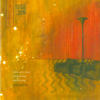 There is something about the way this music sounds that brings back memories of some art long lost in electronic music. There is melody, counterpoint, harmony, rhythms based half way between space and hip-hop, and a completely uplifting feeling throughout. Where We're From... is dance-inspiring, but it isn't a dance record; everything swells and flares slowly, emitting a warm light that radiates for miles around.
There is something about the way this music sounds that brings back memories of some art long lost in electronic music. There is melody, counterpoint, harmony, rhythms based half way between space and hip-hop, and a completely uplifting feeling throughout. Where We're From... is dance-inspiring, but it isn't a dance record; everything swells and flares slowly, emitting a warm light that radiates for miles around. It's pretty incredible to hear a keyboardist thrash along with abassist and drummer. It's even more incredible when the keyboardmanages to sound heavier, more melodic, and threatening (all at thesame time) than any guitar could. Groundswellis the debut album from Parts and Labor and to put it simply: it rocks.It's like being strapped into a jet for the first time and beingintroduced to mach-5 and blackouts. Although the keyboard often holdsthe lead role in each song, it's the duo of bassist BJ Warshaw andeither Jim Sykes or Joel Saladino on drums that propel every song intooverdrive. The entire album sounds as if it could've been recorded inan abandoned warehouse somewhere on northern Jersey's shore. The bassis absolutely unhinged, rattling about as if it were on fire and readyto explode. Above it all is an unexpected partner: the keyboardtwirling, performing loops, convulsing, and generally ejaculating overeverything. It serves another role, however: every now and then gentletones and wavering notes will hover over the near-tribal rhythm sectioncreating an odd juxtaposition of sounds that will either producenightmares or light a fire under my ass and send me into thestratosphere. The music isn't particularly violent, but it's LOUD anddetermined to beat the three minute mile. "TB Strut" also happens to beone of the best headbanging songs I've heard, it's just impossible toresist that melody! As a nice little bonus, Parts and Labor haveincluded a video for "Intervention" on the CD (it's also available ontheir website). It's a fun video in a very twisted way. These guys mustbe monstrous live so hopefully they'll expand their tours a bit furtherwest soon.
It's pretty incredible to hear a keyboardist thrash along with abassist and drummer. It's even more incredible when the keyboardmanages to sound heavier, more melodic, and threatening (all at thesame time) than any guitar could. Groundswellis the debut album from Parts and Labor and to put it simply: it rocks.It's like being strapped into a jet for the first time and beingintroduced to mach-5 and blackouts. Although the keyboard often holdsthe lead role in each song, it's the duo of bassist BJ Warshaw andeither Jim Sykes or Joel Saladino on drums that propel every song intooverdrive. The entire album sounds as if it could've been recorded inan abandoned warehouse somewhere on northern Jersey's shore. The bassis absolutely unhinged, rattling about as if it were on fire and readyto explode. Above it all is an unexpected partner: the keyboardtwirling, performing loops, convulsing, and generally ejaculating overeverything. It serves another role, however: every now and then gentletones and wavering notes will hover over the near-tribal rhythm sectioncreating an odd juxtaposition of sounds that will either producenightmares or light a fire under my ass and send me into thestratosphere. The music isn't particularly violent, but it's LOUD anddetermined to beat the three minute mile. "TB Strut" also happens to beone of the best headbanging songs I've heard, it's just impossible toresist that melody! As a nice little bonus, Parts and Labor haveincluded a video for "Intervention" on the CD (it's also available ontheir website). It's a fun video in a very twisted way. These guys mustbe monstrous live so hopefully they'll expand their tours a bit furtherwest soon.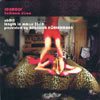 Schmoof are the U.K. duo of Sarah and Lloyd, whose over the top kitsch music is firmly rooted in the style of 70s disco meets 80s synth pop production. I'm usually not one to judge a book (or CD) by its cover, but the pink clad, pixelated figures jumping on a leopard print bedspread on Bedroom Disco doesn't exactly leave too much to the imagination as to the type of music to expect.
Schmoof are the U.K. duo of Sarah and Lloyd, whose over the top kitsch music is firmly rooted in the style of 70s disco meets 80s synth pop production. I'm usually not one to judge a book (or CD) by its cover, but the pink clad, pixelated figures jumping on a leopard print bedspread on Bedroom Disco doesn't exactly leave too much to the imagination as to the type of music to expect.